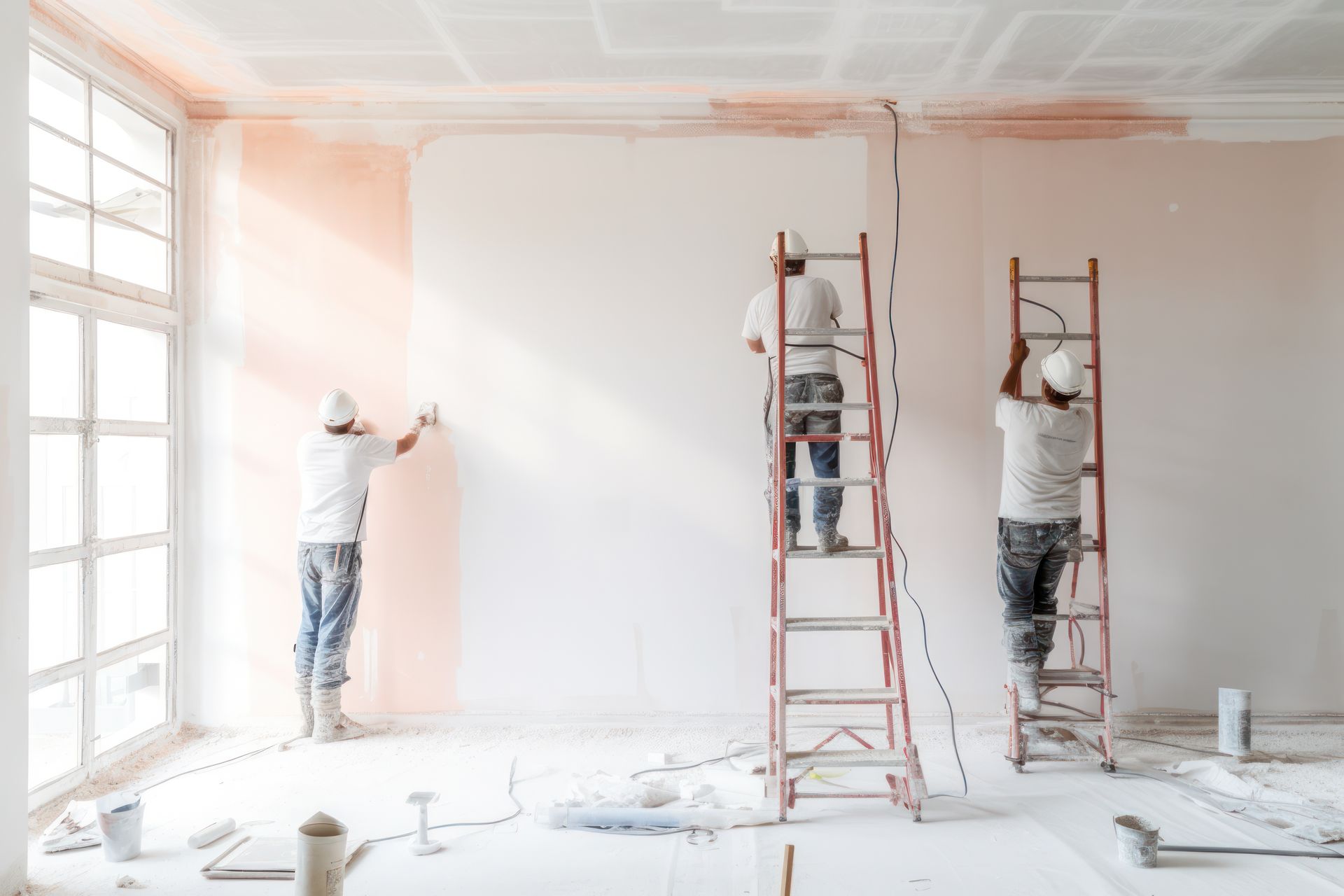Crown molding and decorative trim represent some of the most transformative architectural elements homeowners can add to their Dallas-Fort Worth area properties, instantly elevating ordinary rooms into sophisticated spaces that exude elegance, craftsmanship, and timeless appeal. While many Plano, McKinney, and Frisco homeowners appreciate the visual impact these features create, few understand the critical role that proper painting techniques play in maximizing their aesthetic potential and ensuring these investments deliver the refined appearance that makes crown molding and trim worth installing in the first place. The difference between crown molding that adds genuine elegance to your home and trim work that appears amateurish or distracting often comes down to the quality of the painting application, color selection, and finishing techniques that either enhance or undermine these architectural details that can make your home feel custom and high-end rather than basic and builder-grade.
Understanding the architectural purpose of crown molding and trim helps homeowners appreciate why these elements deserve the specialized painting attention they require to fulfill their design potential and justify their installation costs. Crown molding serves multiple functions beyond simple decoration, creating visual transitions between walls and ceilings that make rooms feel more finished and proportional while adding dimensional interest that flat surfaces lack. Quality trim work around windows, doors, and baseboards frames architectural openings and creates definition that makes spaces feel intentionally designed rather than hastily constructed. These elements work together to create the layered, sophisticated appearance that distinguishes custom homes from basic construction, but only when they're painted with the precision and attention to detail that highlights rather than obscures their refined profiles and proportions.
The psychology of perceived quality in interior spaces heavily depends on the execution of details like crown molding and trim painting, since these visible finish elements immediately communicate the level of care and craftsmanship invested throughout the home. Perfectly painted trim with crisp, clean lines suggests attention to detail that extends to aspects buyers can't see, while sloppy painting with visible brush marks, color bleeding, or inconsistent coverage signals corner-cutting that raises questions about overall construction quality. This perception significantly impacts both daily enjoyment of your living spaces and eventual resale value, making professional-quality trim painting an investment in both immediate aesthetic pleasure and long-term property value that extends far beyond the cost of materials and labor involved in the painting process itself.
Color theory and contrast principles become particularly important when painting crown molding and trim, since these elements must either blend harmoniously with wall colors or provide deliberate contrast that enhances rather than conflicts with the overall room design. Traditional approaches often favor painting trim in colors lighter than wall surfaces, creating definition through subtle contrast that makes architectural details more prominent without overwhelming the space. However, contemporary design trends increasingly embrace dramatic contrast through dark trim against light walls or monochromatic schemes where trim and walls share similar tones but different sheens that create subtle definition through light reflection rather than color variance. Understanding these options and their visual effects helps homeowners make informed decisions that enhance their specific room proportions and design goals rather than simply following generic advice that may not suit their particular circumstances.
Surface preparation requirements for crown molding and trim differ significantly from wall painting, demanding more meticulous attention to detail and specialized techniques that ensure paint adheres properly to these three-dimensional surfaces while creating the smooth, flawless finish that makes architectural details appear professional rather than DIY. New wood trim requires careful sanding to remove mill marks and imperfections, proper priming to seal wood grain and prevent tannin bleeding, and filling of nail holes and joints with quality wood filler that won't shrink or crack over time. Previously painted trim often needs more extensive preparation including removal of loose or peeling paint, repair of damaged areas, and thorough cleaning to remove accumulated dirt and grease that can prevent proper adhesion of new coatings. This preparation phase typically requires more time than the actual painting but determines whether the finished result looks professional or amateurish.
Material selection for crown molding and trim painting involves choosing products specifically formulated to handle the unique challenges these applications present, including resistance to wear from cleaning, durability in high-touch areas, and the ability to maintain crisp lines and smooth surfaces over time. Semi-gloss and satin sheens typically work best for trim applications because they provide durability and cleanability while maintaining the sophisticated appearance that makes architectural details attractive. However, sheen selection must also consider room lighting, wall colors, and personal preferences, since higher sheens amplify both positive details and surface imperfections that might remain invisible under flat finishes. Quality primer selection becomes particularly crucial for trim painting because these surfaces often involve different materials, previous coatings, and stress points that require specialized adhesion and blocking properties to prevent future problems.
Professional application techniques separate exceptional trim painting from adequate results, with specific methods required to achieve the clean lines, uniform coverage, and flawless finish that makes crown molding and trim appear elegant rather than sloppy. Brush selection and technique significantly affect final appearance, with high-quality angled brushes allowing precise control around detailed profiles while maintaining smooth application that doesn't leave visible brush marks or texture inconsistencies. Cutting in techniques require steady hands and proper brush loading to create clean transitions between trim and wall colors without bleeding or overlapping that creates unprofessional appearance. Multiple thin coats typically produce superior results compared to single thick applications, allowing each layer to level properly while building up the uniform coverage and depth of color that makes trim work appear substantial and well-executed.
Timing and sequence considerations affect both the efficiency and quality of crown molding and trim painting projects, with proper planning ensuring that each element receives appropriate attention while minimizing the risk of damage to completed work. Trim painting typically occurs after wall painting when protecting finished trim becomes easier, though this sequence requires careful masking and protection to prevent wall paint from contaminating trim surfaces. However, some situations benefit from priming trim before wall painting, particularly when using different primer types or when trim requires extensive preparation that might damage wall surfaces. Understanding these timing considerations helps ensure efficient project completion while maintaining quality standards throughout the process.
Detail work and precision requirements for crown molding painting demand specialized skills and techniques that distinguish professional results from amateur attempts, particularly around complex intersections, corners, and junction points where different trim elements meet. Coping and mitering details require careful paint application that doesn't obscure the precise fits that make these joints appear seamless and professional. Inside and outside corners present particular challenges, often requiring hand-brushing techniques that ensure complete coverage while maintaining clean lines and preventing paint buildup that can blur crisp architectural details. These precision requirements explain why crown molding and trim painting often takes significantly longer than wall painting despite covering much smaller surface areas.
Color coordination strategies help homeowners select trim colors that enhance their overall design vision while avoiding common mistakes that can make architectural details feel disconnected from the broader room aesthetic. Monochromatic approaches using variations of the same color family create sophisticated, unified appearance that makes spaces feel larger and more cohesive, while contrasting schemes can define architectural elements more dramatically but require careful balance to avoid overwhelming the space. White and off-white trim colors remain popular because they coordinate with virtually any wall color while creating the classic, timeless appearance that appeals to broad audiences, but bolder trim colors can create distinctive character when executed thoughtfully on appropriate architecture. Understanding how different color approaches affect room perception helps homeowners make choices aligned with their design goals and lifestyle preferences.
Maintenance and longevity considerations become important factors in crown molding and trim painting decisions, since these high-visibility elements require consistent appearance over time to maintain their elegant contribution to interior design. Quality paint systems and proper application techniques significantly extend the time between repainting cycles, protecting the investment in both materials and installation labor while maintaining the refined appearance that makes these architectural elements worthwhile. However, even quality trim painting eventually requires refreshing, and understanding maintenance requirements helps homeowners plan for long-term care that preserves their investment. Regular cleaning, prompt attention to damage, and periodic touch-ups help extend paint life while maintaining the crisp, clean appearance that makes crown molding and trim attractive.
Common mistakes in crown molding and trim painting can undermine even quality millwork, creating results that detract from rather than enhance interior aesthetics despite significant investment in materials and installation. Poor surface preparation frequently causes premature paint failure, while inadequate primer selection can result in tannin bleeding, poor adhesion, or color variations that become apparent over time. Rushing application techniques often produces visible brush marks, uneven coverage, or bleeding between trim and wall colors that creates unprofessional appearance. Using inappropriate paint products—particularly flat sheens that show every fingerprint or low-quality paints that don't provide adequate coverage—can make expensive trim work appear cheap and poorly executed despite perfect installation.
Design integration principles help ensure that painted crown molding and trim enhance rather than compete with other room elements, creating cohesive spaces where architectural details support the overall aesthetic vision rather than appearing randomly applied or disconnected from the design concept. Room proportions significantly influence appropriate trim size and color choices, with larger moldings requiring different color approaches than delicate profiles to maintain visual balance. Furniture placement, lighting design, and decorative elements all interact with painted trim colors, requiring thoughtful coordination that considers the complete room environment rather than treating trim painting as an isolated decision. Understanding these relationships helps homeowners create spaces where all elements work together harmoniously.
Historical and architectural authenticity considerations become relevant for homes where crown molding and trim should honor the original design intent rather than imposing contemporary preferences that conflict with the architectural style. Colonial homes, craftsman bungalows, and traditional styles each carry specific conventions about appropriate trim colors and finishes that help maintain period authenticity while accommodating modern preferences. However, contemporary homes offer more flexibility in trim color selection, allowing for bolder choices that might appear inappropriate on historical architecture. Understanding these distinctions helps homeowners make choices that enhance rather than undermine their home's architectural character while achieving the aesthetic goals that motivated the crown molding installation.
Professional versus DIY considerations involve understanding the skill level, time commitment, and tool requirements necessary to achieve professional-quality crown molding and trim painting results that justify the investment in these architectural elements. While wall painting can often be successfully completed by determined homeowners, trim painting demands precision, technique, and experience that typically produce better results when handled by professional painters who specialize in detailed finish work. The cost difference between professional and DIY trim painting often proves minimal when considering the time investment, tool requirements, and risk of unsatisfactory results that require professional correction anyway. Additionally, professional painters carry insurance coverage that protects homeowners from liability and provides recourse if problems develop with the completed work.
Technology and tool advances continue to improve crown molding and trim painting outcomes through better brushes, specialized application tools, and improved paint formulations designed specifically for detailed finish work. High-quality synthetic brushes now rival natural bristle performance while offering easier cleanup and longer service life. Paint additives that extend working time and improve leveling help achieve smoother finishes, while specialized masking products create cleaner lines with less risk of bleeding or damage during removal. Professional painters invest in these advanced tools and materials, leveraging technology improvements to deliver superior results more efficiently than DIY approaches using basic consumer-grade equipment.
Cost-benefit analysis of crown molding and trim painting reveals that professional-quality work provides excellent return on investment through both immediate aesthetic enhancement and long-term property value protection that extends far beyond the initial expense. Quality trim painting can make builder-grade millwork appear custom and expensive, while poor painting can make expensive custom millwork look cheap and poorly executed. This multiplier effect means that investing in professional painting maximizes the value of crown molding and trim installation while ensuring these elements contribute positively to both daily enjoyment and eventual resale appeal. The difference in cost between adequate and exceptional trim painting often proves minimal compared to the dramatic difference in results and longevity.
When you're ready to transform your home's interior with elegantly painted crown molding and trim that showcases the architectural details and craftsmanship your space deserves, Hutch'N'Son Painting brings the specialized skills and attention to detail that Dallas-Fort Worth homeowners have trusted since 1985. Our experienced team understands the precision requirements and specialized techniques that crown molding and trim painting demands, from meticulous surface preparation through final detail work that creates the clean lines and flawless finish that makes architectural elements appear professionally executed and elegantly sophisticated. We work with you to select colors and finishes that enhance your home's unique character while ensuring long-lasting results that protect your investment in these beautiful architectural details. Contact Hutch'N'Son Painting today to schedule your consultation and discover how expert crown molding and trim painting can elevate your home's interior elegance to the level of refinement and quality your family deserves.






